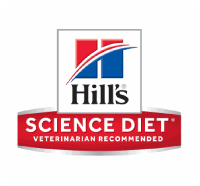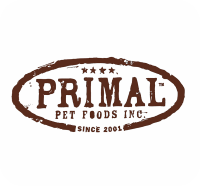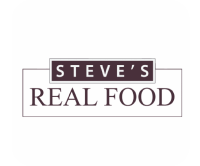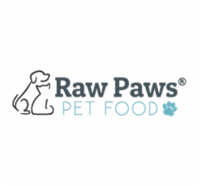How can you be sure that you’re feeding your cat the right diet? It can be tricky to decide what’s best, as most brands use specific language to encourage consumers to purchase what they’re offering.
A quick trip through the cat food aisle at your local pet store reveals terminology such as “complete and balanced,” “meets cats’ nutritional requirements,” and more.
Even though most commercial diets contain the right macronutrients for an average cat, they’re not all created equal. For example, kittens require more nutrients than adult cats, and older cats tend to thrive on senior diets.
Some cats have health issues that call for special diets, and others have allergies. In this guide, we cover cat food nutrition, kitten nutrition, and much more, all to make it easier for you to choose the right food for your cat. With a proper diet, your cat will enjoy a longer, happier, and healthier life!
To develop this guide to the best cat food, we scoured the market – where you’ll find well over 2,000 different brands and formulas – plus we talked to veterinarians about cat nutritional needs and common nutrition-related issues faced by our feline companions.
The Basics of Feline Nutrition
Cats are cute and cuddly, but they’re also obligate carnivores. This means that their bodies need meat.
According to the National Research Council’s science-based guide for pet owners, animal-based protein is much easier for cats to digest than plant-based protein, and it is more suitable for the feline digestive system. Furthermore, the guide notes that carbohydrates are an abundant source of energy (calories).
Because a high-carbohydrate diet can cause complications including obesity and diabetes, it’s important to pay attention to macronutrient percentages when deciding which brand to feed your feline friend.

In a Swedish study of cats visiting an academic medical center, a full 45 percent of the cats were overweight, and there was a direct link with diets consisting of dry food.
There is an ongoing debate between various entities in the pet food industry and veterinary researchers as to whether cats should eat any grains or starchy vegetables at all.
The general consensus among feline nutrition experts is this: Small amounts are OK since cats that kill and eat prey animals also consume those herbivores’ stomach contents, but that grains like corn certainly shouldn’t be at the top of the ingredients list.

At the same time, it’s worth noting that the National Research Council’s Subcommittee on Cat Nutrition states that there is no known dietary carbohydrate requirement for cats. Holistic veterinarians like Dr. Angie Krause often recommend keeping grains to a minimum or eliminating them altogether. This leads us to conclude that grains and starchy vegetables should be complementary and kept to a minimum if they’re fed at all.
In nature, cats eat birds, small animals, and the occasional insect. According to the World Small Animal Veterinary Association, the wild cat’s diet is approximately 55 percent protein, 45 percent fat, and just 1 to 2 percent carbohydrates.
This is perfect for our domesticated cats too, as their bodies are designed to metabolize protein and fat for energy. In contrast, commercial cat food is all over the carts, sometimes containing up to 50 percent carbohydrates. Just like we humans do, cats store extra carbs as fat.
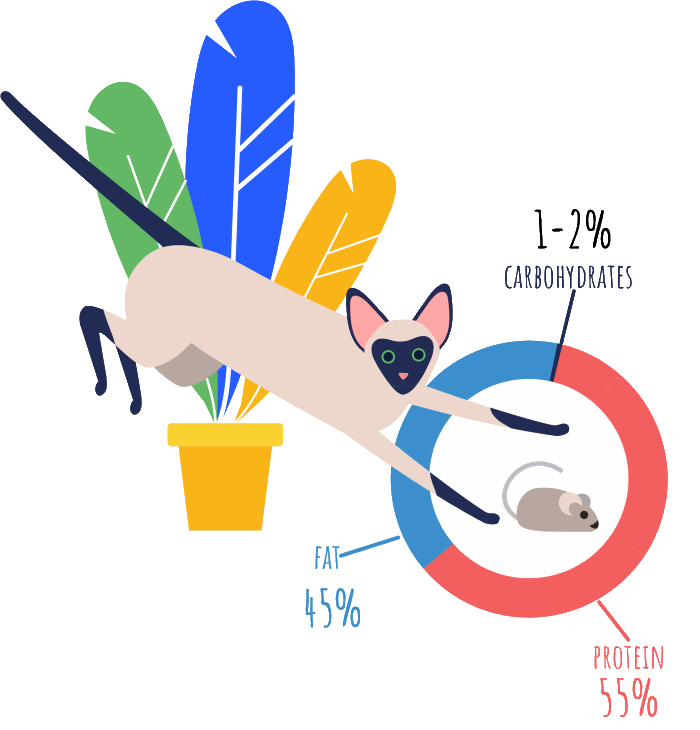
Cats have some unique nutritional needs in other areas, too. They can’t synthesize vitamin A from beta-carotene, so their food must contain preformed vitamin A. In the wild and in raw cat diets, this comes from liver.
They also need high levels of taurine and arginine, which are two essential amino acids, so the focus needs to be on high-quality ingredients including meat and animal fat – not grains and vegetable oil. Based on guidelines from the National Academy of Science’s Committee on Nutrient Requirements of Dogs and Cats, here are a few more things to look for when choosing the healthiest cat food:




Unfortunately, some manufacturers rely on cheap fillers and artificial flavors, plus artificial preservatives like TBHQ, BHT, and BHA, and other additives that can harm your cat’s health over time.
Some retailers – notably PETCO – see this is a problem, and recently announced that they will stop carrying pet foods and treats that contain artificial ingredients.
When choosing the best food for your cat, the Feline Nutrition Foundation and other unbiased, non-industry sources recommend that it’s best to choose options that mimic a cat’s natural diet.
Should your cat eat a raw diet?
There is a risk of bacterial contamination when making raw cat food at home and our extensive research of professional opinions shows that many veterinarians are on the fence about the drawbacks vs. benefits of raw diets for cats.
At the same time, it’s clear that raw food is closest to nature, and with careful attention to ingredients, raw food might be ideal. It’s easier now than ever to feed your cat a raw diet, as some companies specialize in producing balanced raw diets for cats as well as convenient freeze-dried options.
This alternative ensures proper nutrition based on cats’ biological needs, plus it’s more convenient than making homemade cat food. We’ll dive deeper into all the best options shortly.
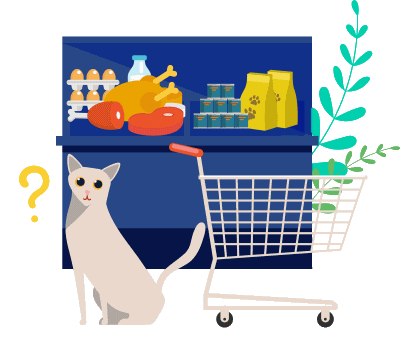
Cat Feeding Schedule
Many of us free feed our cats, simply topping up their bowls with their favorite kibble so that they’re able to snack at will, day in and day out. As convenient as free feeding might be for us, it’s not doing our cats any favors.
In the wild, cats tend to eat their main meals at dawn and dusk, times that coincide with peak hunting hours.
They’ll often eat small meals over the course of the day, between naps. If you were able to watch a wild cat’s eating schedule, you would notice that most cats prefer to eat something every five to six hours. That’s ideal, but it might not be a good fit for your own schedule.
Ideally, your cat feeding schedule should include small meals throughout the day. Think mouse-sized portions or smaller.
If you can only feed your cat once in the morning and once again in the evening, you might want to invest in an automatic feeder with a timer. There are many models available, and these allow you to provide meals on schedule.
There are obvious challenges that come with sticking to specific feeding schedule, particularly when you have multiple cats and you’re trying to control portions or feed different diets. Here are a few things to consider:

Hire a pet sitter to come in and feed your cats once or twice during the middle of the day.
If cats are prone to competing over food, feed them in separate rooms, or in carriers with the doors closed, placed far enough apart so neither cat feels threatened by the other.

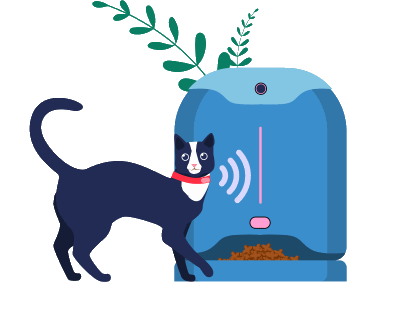
Try smart feeders that only open for certain cats. These pair with your cat’s microchip or an RFID tag that you can put on your cat’s collar.
One of the most important ingredients in cat food is often missing: Water. Cats eating a diet that consists mostly of dry food are chronically dehydrated and prone to urinary tract issues, kidney disease, and other complications.
For this reason, it’s best to feed at least some wet food, and to ensure that your cat always has access to fresh water. Invest in a fountain with moving water, or change your cat’s water at least twice a day to encourage them to drink more.
Cat Diet Depending on Breed and Age
Do different cat breeds need different types of food? The short answer to this question is no. All cats – from long-haired breeds such as Persians and Maine Coons to short-haired cats like Siamese and Abyssinians need the same healthy diet.
Whether you have well-bred show cats or beloved shelter pets of indeterminate heritage, their nutritional needs are all the same! It’s worth noting that a special cat hairball control food might benefit long-haired cats, but daily brushing might help even more since high-fiber cat diets have been linked to an increased risk of bladder inflammation.
When it comes to age, a different set of rules apply. Kitten nutrition is different from adult cat nutrition, and older cats really do need to eat senior cat food.
Kitten foods are specially formulated to support healthy growth, with added vitamins and minerals, plus more calories.
With proper nutrition, kittens develop healthy immune systems. While there are some formulas designed to support good health at all ages, kittens should switch to adult food when they are one year old.

Adult cats – generally those between the ages of one and seven – and mature cats between age eight and ten – should eat a diet based on meat and fat, with relatively low carbohydrates.
Most cats over age 11 are considered seniors. While many cats will continue to thrive on a good-quality adult cat food, a lower-calorie senior cat food can help prevent rapid weight gain.
Again, we’d like to stress the importance of keeping carbohydrate intake low to prevent obesity and reduce the risk of diabetes as your cat ages and spends more time relaxing.
The Cummings Veterinary Medical Center at Tufts University mentions that it’s not necessary to reduce protein content when feeding a senior cat; in fact, this might contribute to muscle loss.
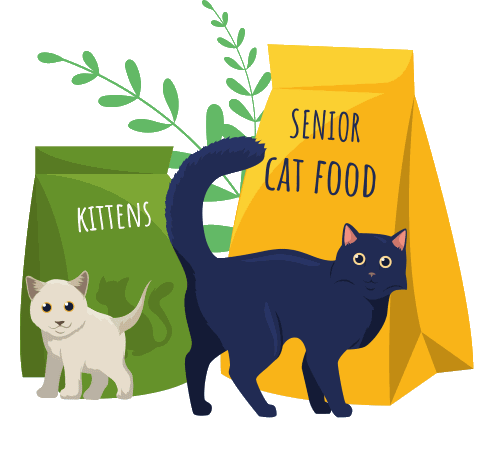
Some diets are appropriate for cats of all ages. Not surprisingly, this includes raw diets and freeze-dried meat-based diets.
A few companies go the extra mile by delivering freshly-made cat food and adjusting nutrients according to your cat’s life stage and nutritional needs. These meals do cost more, but they offer convenience for you and nutrients tailored to your feline friend’s specific requirements.
Cat Diet Depending on Health Issues
If your cat has kidney disease, diabetes, feline lower urinary tract disease (FLUTD), or another condition, your vet might recommend a prescription diet. If you have the choice between dry food and wet, try to remember our advice about water intake and give your cat as much wet food as possible.
What if your cat isn’t thriving on the diet that your vet recommended? It’s possible that she might not be getting enough water, or that there may be another imbalance somewhere. See if your vet can recommend something else, or consider having a consultation with a veterinary nutritionist.
Also consider whether your cat might have another underlying condition! Your veterinarian is your cat’s best friend here; bloodwork and other diagnostics can help sort things out when prescription food doesn’t seem to be working.
Dealing with Cat Food Allergies

Cat food allergy symptoms include sneezing, chewing on paws, scratching relentlessly, even to the point of bleeding, snoring, vomiting, diarrhea, and a dull, coarse coat. If you think that your cat has food allergies, get her to the vet right away.
Medications can provide relief, and a food elimination diet can help identify which ingredients are to blame.
Common cat food allergens include:
- Beef
- Dairy
- Seafood
- Artificial colors
- Corn and corn products
- Preservatives, i.e. BHA and BHT
- Soy
- Wheat
- Eggs
Feeding Cats with Urinary Issues

According to research published by the Journal of the American Veterinary Medical Association, the Hebrew University of Jerusalem’s Koret School of Veterinary Medicine and other entities, dry food is a terrible choice for cats with FLUTD and other urinary issues, primarily because cats are designed to get most of their water from the food they eat.
Studies show that dry food can contribute to chronic dehydration, which results in increased urine concentration and a far greater likelihood that stones and crystals will form and lead to life-threatening blockages.
If your cat has FLUTD or another urinary tract issue, your vet will be able to recommend a specific diet – and it is likely to consist of wet food rather than dry.
If your cat is accustomed to dry food and turns her nose up at everything else, you might be able to entice him to try a special uretic canned food by sprinkling some of his kibble on top. Most cats take some time to adjust to a new diet, but by gradually decreasing the amount of old food and increasing the amount of new food, you can usually ensure that the transition happens seamlessly.
Feeding Cats with Diabetes
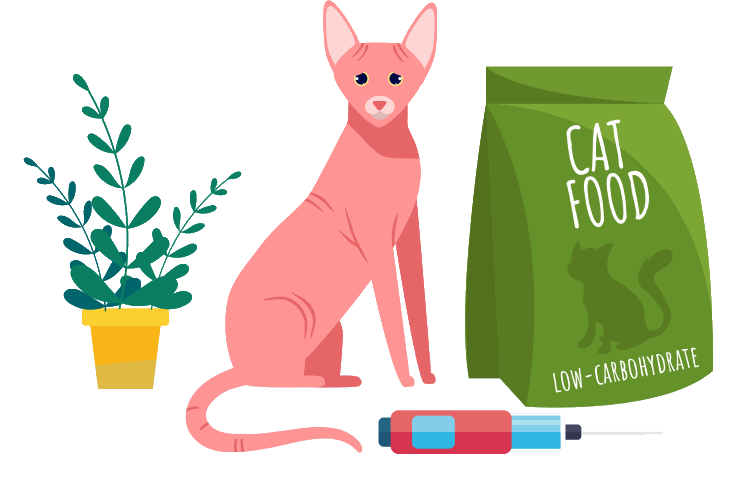
According to the World Small Animal Veterinary Association, many diabetic cats are stabilized once they’re placed on low-carbohydrate diets, and often, the diabetes goes away entirely. In one study, 68 percent of diabetic cats placed on a low-carbohydrate diet were able to discontinue insulin.
If your cat is on insulin for diabetes, be sure to work with your vet as you transition toward a low-carbohydrate diet. Depending on whether your cat has other conditions such as pancreatitis or liver disease, you may be able to choose a low-carbohydrate commercial food like the ones in our guide, or you might consider making your cat’s food from scratch.
Homemade Cat Food vs. Store-Bought
Homemade cat food is less convenient than store-bought, however it places you in complete control of your cat’s diet. If your cat has an allergy, for example, you can easily keep even the smallest trace of that allergen out of your pet’s food by making it yourself.
You know that there are no weird, unsanitary, or potentially unsafe ingredients going into the mix, and with convenient pre-mixed nutrient blends, it is very easy to give your cat everything she needs including taurine, the right amount of preformed vitamin A, and more.
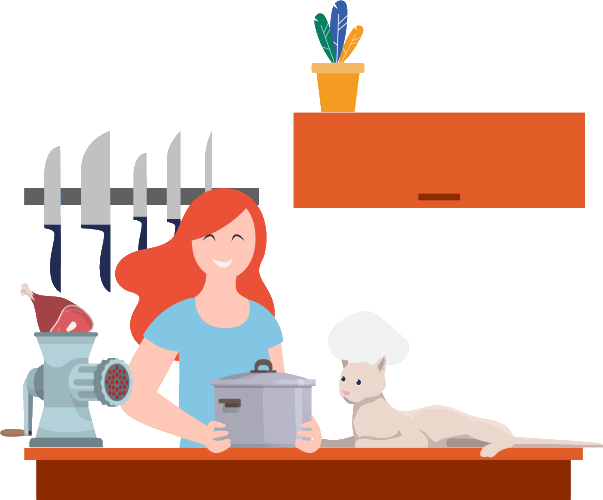
In case you’re worried about sanitation, remember that you’re in control of keeping your surfaces, tools, and containers clean. Additionally, cats have very strong stomach acid that kills bacteria, and as an extra layer of protection, they tend to turn their noses up at anything that isn’t perfectly fresh. Most won’t even consider eating food that’s starting to spoil.
Making homemade cat food calls for special tools. Since DIY cat food recipes call for bones with nutritious marrow inside, you need a good meat grinder to ensure that everything is well-incorporated. Bone meal is a close second, but its nutrient profile is a little different since it’s not fresh.
You’ll need sharp knives to cut some of the meat into larger chunks that satisfy your cat’s predatory nature, and you’ll need good cutting boards, along with containers that you can label. A food scale is essential unless you can get a butcher to weigh everything for you when you purchase it.

Some people freeze their fresh cat food in ice cube trays designated for cat food only and sanitized after every use, making portion control simple. After freezing individual cubes, all the cubes can be wrapped in butcher paper or wax paper and then tucked together into freezer bags.
Despite the need for special equipment and containers to store your cat’s food in the freezer plus the willingness to thaw food for your cat ahead of every meal, you’ll find that homemade cat food is a cost-effective alternative to store-bought brands.
It’s up to you to do a cost-benefits analysis! Depending on your schedule and the value of your own time, it might pay to simply pick a high-quality brand and be done with it.
Homemade Cat Food Recipes
You can find quite a few homemade cat food recipes online – just be sure to watch out for known allergens and avoid recipes that look like they contain lots of carbohydrates. Here is one to get you started. We adapted this homemade raw cat food recipe from one that was published by the non-profit Feline Nutrition Foundation. It makes enough food to feed one cat for about two weeks.

Ingredients:
- 4.5 pounds raw chicken thighs with skin; remove about 25% of the bones
- 14 ounces raw chicken hearts
- 7 ounces raw chicken liver
- 4 raw egg yolks
- 1 cup water
- 200 IU vitamin E
- 200mg vitamin B complex
- 4000mg fish oil
- 2000mg taurine
- 1 ½ teaspoons lite salt
Instructions:
- Set up your work area with everything needed for your start-to-finish process.
- Weigh ingredients (do this after you remove 25% of the bones)
- Set a quarter of the meat aside. This will be cut into bite-size strips or chunks that will help clean your cat’s teeth.
- Grind the rest of the meat, hearts, liver, and bones. Discard any obvious large bone chunks.
- In a 2-gallon bowl (or larger), whisk the egg yolks, vitamins, and water together. Add the meat a little at a time, mixing with a large metal spoon to make sure that the vitamins and egg yolks are thoroughly incorporated.
- Transfer your cat’s food into clean storage containers. Plan to give each cat about 6 ounces of food per day, and consider using ice cube trays to create individual servings (think mouse-size portions). You can weigh the first few, and then if you’re feeling confident, eyeball the rest. Think about how many times a day you plan to feed your cat – if it’s four times, you’ll want 1.5-ounce portions; if its three times, you’ll want 2-ounce portions, and if it’s two times, you’ll want 3-ounce portions.
- Set enough portions aside for today and tomorrow. Freeze the rest.
- Clean up with a bleach solution or another anti-bacterial solution that’s suitable for cleaning up after raw meat. Be sure to check your meat grinder for specific breakdown and cleaning instructions.
- Watch your cat chow down! Most cats are very eager to try this recipe.
Cat Nutritional Supplements & Vitamins: The Low-Down
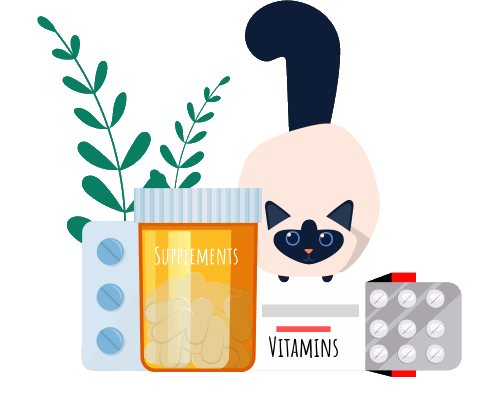
Many of us take vitamins and other supplements. Should we be giving them to our cats, too?
Unless you are making your own cat food and adding essential nutrients according to a recipe formulated by a feline nutrition expert, it’s probably not necessary. Bernadine Cruz, DVM, of the American Veterinary Medical Association Council on Communications says that it’s best to take supplement manufacturers’ recommendations with a grain of salt.
In an interview, Cruz cautioned that “anyone, regardless of their expertise, can set up a web site and claim that their product can make your pet feel younger and have increased energy.”
Industry advocates say that their products can help cats live longer and stay healthier.
But Cruz, the Pet Food Institute, and other feline nutrition experts disagree, saying that a good-quality cat food is all that most cats need, unless your veterinarian recommends supplementing in the event of illness.
Dr. Cruz has additional recommendations regarding supplementation:
- Pregnant and nursing cats sometimes develop nutritional deficiencies. Your vet can help you determine if a queen needs additional nutrients.
- If your cat has small intestinal disease and isn’t able to absorb cobalamine and folate (two essential B vitamins), supplementation takes place via injection, since oral supplements can’t be absorbed.
- Essential fatty acids can boost heart health, help keep your cat’s coat shiny, and provide benefits for your cat’s eyes, brain, liver, joints, and immune system. Many cat foods contain the right amount of Omega-3 and Omega-6 fatty acids, but your vet might recommend supplementing.
At the same time, Dr. Cruz says that it’s very important for consumers to be aware that “natural does not always mean safe or effective.” Too much calcium or vitamin D can be toxic, and too much vitamin C can lead to overly acidic urine, crystal formation, and blocked urinary tract.
Since supplements have the potential to harm instead of help, it’s vital to talk with your vet if you’re thinking about supplementation. They can help you determine whether a supplement is helpful or harmful, or if it’s simply an expensive fad.
Key Statistics and Trends in the Cat Food Industry
Statistics from the Nielsen Company and other key research organizations including Watt Global Media reveal that the cat food industry is responding well to veterinarians’ and pet owners’ demands for better pet nutrition based on cats’ physiological requirements. Here are some key findings.

- Cat owners want to make healthy choices rather than indulgent ones, and pet food manufacturers are responding in kind, adding functional ingredients such as turmeric, coconut oil, fish oil, and even CBD to food and treats.
- According to PetMD, top pet food companies are no longer seeking to merely meet minimum nutritional requirements. Instead, they’re looking for ways to optimize health via high-quality nutrition.
- Pet owners aren’t just concerned about consuming genetically modified ingredients themselves, they’re also concerned about keeping GMOs out of their pets’ diets. In one survey, 35% of pet owners told researchers that they ranked “non-GMO” as one of their top three concerns when deciding which pet food to purchase. Other terminology like “Organic” and “Scientifically formulated” were important too, but they took a back seat to “non-GMO.”
- Ingredient quality is now the #1 concern among pet food industry professionals. Meeting pet food consumer demands is second on the list, and the price of ingredients, packaging, and other cots is the industry’s third-highest priority.
- More consumers are buying their cat food online. In 2018, Amazon alone saw a 34 percent increase in pet food sales.
- Market research shows that cat owners want a combination of healthful ingredients, convenience, and relative affordability, and many recognize that feeding a quality diet is likely to result in cost savings via reduced vet bills. Pet food companies are responding with innovative options such as freeze-dried raw diets, as well as foods that can be reconstituted to provide all the benefits of wet food without the higher shipping and packaging costs associated with traditional canned and pouch-packaged wet cat foods.
- Grain-free doesn’t necessarily mean low carbohydrate. The fact that it can be a marketing term calls for careful analysis of foods you’re considering for your cat. A recent study by Cummings Veterinary Medical Center at Tufts University showed that foods with alternative carbohydrate sources such as legumes, potato, or sweet potato were often lower in carbohydrates than their grain-containing contemporaries, but that some brands contained similar carbohydrate levels.
Product Comparison: The Most Popular Cat Foods 2024
With an eye toward optimal nutrition, here are the most popular cat foods for 2024. We’ve broken these recommendations down into three categories: Good, Better, and Best.
Good Cat Foods for 2024
If you’re on a tight budget, you’ll find that these food options provide a good balance of nutrients. The companies that manufacture them are highly-rated in general, however the foods aren’t always grain-free or low in carbohydrates. If you choose one of these foods, you may want to spend extra time playing with your cat so that she doesn’t gain weight and increase her diabetes risk.
Purina ONE
Purina ONE is a complete line of dry and wet cat food. The company focuses on using real meat and fish, and offers several different products including foods for cats with sensitive systems and cats with a tendency to develop hairballs. There are several wet and dry formulas from which to choose.
Fancy Feast
Fancy Feast is a Purina brand that focuses on individually portioned meals made with real ingredients including meat and fish. The Filets are very nice – tuna, salmon, chicken, and ocean fish, making for a very low-carbohydrate treat that can supplement other foods. Broths, appetizers, and natural wet cat foods without grain or fillers are excellent additions to the menu. Be careful because some of these foods contain milk or cheese, which aren’t well-tolerated by some cats.
Better Cat Foods For 2024
These foods are designed for quality and great nutrition. Each company has an excellent reputation and some companies offer specially formulated diets for cats with allergies and sensitive stomachs.
Natural Balance
Natural Balance cat food has quite a few good things going for it: It’s made in the U.S., every batch is tested for safety at a certified reference laboratory, and there’s a satisfaction guarantee. While some recipes do include vegetable proteins, many use real meat as a first ingredient. This brand offers a range of limited ingredient diets for cats with allergies to certain ingredients, with both wet and dry formulas to choose from. Be sure to look at ingredients since some formulas have peas as a first ingredient instead of meat, and as the dry formulas tend to be relatively high in carbohydrates.
Taste of the Wild
Taste of the Wild focuses on delivering the right balance of protein, fat, and carbohydrates. Although some of the proteins in this food are vegetable-based, there’s plenty of quality animal protein in each recipe as well. The company’s product line includes a variety of wet foods as well as a few dry flavors.
Hill’s Science Diet
According to Hill’s, Science Diet cat foods offer biology-based nutrition along with high-quality ingredients. This company offers a 100 percent satisfaction guarantee, so if you or your cat find anything you don’t like about the food, you can return it for a full refund. If your cat has a medical condition, it’s likely that your vet might recommend one of the special diets from Hill’s. Both wet foods and dry foods are available.
Rachael Ray Nutrish
When Rachael Ray introduced Nutrish pet food, people were thrilled. This food uses real ingredients, although many recipes do include grains and starchy vegetables. At the same time, the product line does include zero-grain recipes including wet foods and ultra high-moisture broths designed to use as treats or to complement other cat foods. You can find Nutrish online and in many stores, so it’s a convenient option whatever your shopping preference.
The Best Cat Foods For 2024
These foods are specifically designed to keep protein and fat content high, and to minimize carbohydrates.

Smalls
Smalls is a company that makes fresh, human-grade meals, portions them out according to your cat’s needs, and ships them to your front door. Almost every aspect of the Smalls experience is personalized, from specially-portioned food to custom delivery schedules to an engaged customer care team.
Smalls cat food is a good choice for anyone who wants fresher, simpler, more species-appropriate food than the dry and canned fare sold in pet stores and on grocery shelves.
Primal
Primal is a whole-food diet for cats, with frozen raw formulas as well as freeze-dried options for greater convenience. There are several different varieties to choose from, which is nice if your cat has limitations such as a chicken allergy.
Nature’s Variety
If you’re not interested in feeding a raw or homemade diet, Nature’s Variety is a close second, with high-protein options that are grain-free as well as free from high-carbohydrate starches. These blends are made in the USA, and come in both wet and dry flavors. You can also get freeze-dried “raw boost” mixers and kibble with pieces of freeze-dried meat mixed in.
Hare Today
Hare Today is a solution for people who want to feed their cats a raw homemade diet, but who don’t want to worry about grinding meat and getting organ ratios right. The company also offers balanced supplement packs (including taurine) for adding to homemade cat food. It’s also famous for its frozen, vacuum-sealed whole prey, which many cats like, but which can be very off-putting for squeamish pet owners. The mice, rats, chicks, and guinea pigs on offer are humanely euthanized with Co2. Freeze-dried options are also available as a convenient alternative to raw and whole prey choices.
Hound & Gatos Canned Foods
Hound & Gatos is a favorite not just because they offer so many different flavors to keep your cat well-nourished and interested in his food, but because it is made with 100% animal protein. This is some of the best grain-free cat food on the market, and the company does an excellent job of ensuring that all essential nutrients are included.
Steve’s Real Food
Offering raw frozen and freeze-dried options, Steve’s Real Food blends real meat with biologically appropriate ingredients such as krill in its line of Quest cat foods. The first ingredient is always free range and/or grass-fed meat or poultry, and there are no grains to be seen. This food is conveniently formed into bite-sized nuggets. It’s freeze-dried, so you don’t have to worry about thawing anything out.
Raw Paws Pet Food Freeze Dried Complete Chicken
Use AAC10 Coupon Code To Get 10% Off Your Entire Order!
If you love the convenience of dry food but you want to treat your pet to superior nutrition, Raw Paws might be ideal. This food is made from a blend of 45% muscle meat, 45% organs, and 10 percent bone, and it is packaged in a resealable bag. One pound of this freeze-dried food is the equivalent of three pounds of raw food.
Raw Paws also offers frozen complete blends that let you feed your cat a balanced raw diet without having to make it yourself. These blends are very easy to portion out, and they’re easy to store in the freezer, too.
Ziwi Peak Cat Food
Ziwi Peak wet cat food is made with meat, organs, and bones. It’s grain-free, very low in carbohydrates, and free from anything artificial. The company also offers a unique air-dried cat food for convenience. It is 96 percent meat, organs, and bone, 7 percent tripe, and 3% green mussel, which provide natural glucosamine and chondroitin.
There are quite a few different flavors to choose from, as well as different-sized cans and bags. Like other foods that made their way onto this list, it’s available at many pet stores as well as online.
Vet-Answered FAQs
Why can’t I feed my cat a vegetarian or vegan diet?
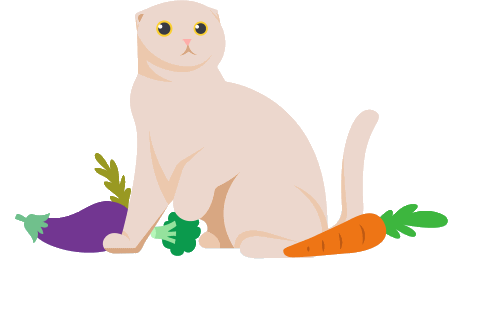
 Cat’s have a very high requirement for protein in the diet. The building blocks of the body are what we call “amino acids”, and there are 23 of these to create the mammalian body.
Cat’s have a very high requirement for protein in the diet. The building blocks of the body are what we call “amino acids”, and there are 23 of these to create the mammalian body.
Cats are able to produce 12 of these themselves, but 11 of these they are unable to make and have to be obtained from the diet, called “essential amino acids.” Cats also have a requirement for pre-formed vitamins (such as vitamin A and vitamin B3) and a vegetarian or vegan diet simply does not provide enough of these proteins and vitamins for cats to be healthy.
Deficiencies in some of the essential amino acids can cause serious disease in the cat, for example a taurine deficiency can cause serious heart disease. In short, cats must eat meat to survive; there is no way a cat can be healthy and vegan or vegetarian.
Can I feed my cat the same food I feed my dog?
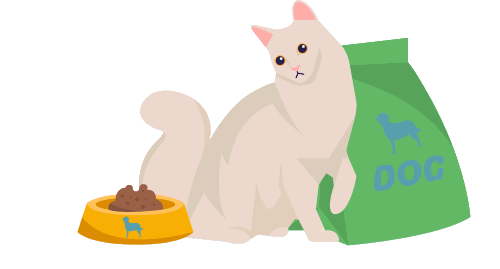
 In short; no. You cannot feed your cat the same diet as what your dog gets. Cat food is higher in pre-formed proteins and vitamins which are essential in the diet of cats, whereas dog food doesn’t need these same high levels of these proteins.
In short; no. You cannot feed your cat the same diet as what your dog gets. Cat food is higher in pre-formed proteins and vitamins which are essential in the diet of cats, whereas dog food doesn’t need these same high levels of these proteins.
Over time, if your cat is eating dog food they will develop dietary deficiencies which will cause serious health problems.
What are signs that my cat might be allergic to chicken?
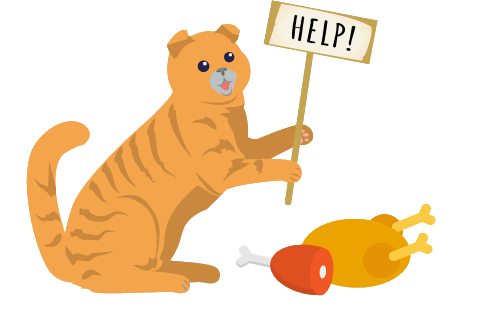
 There are a few different signs which can alert you to dietary allergies in the cat. The first and most obvious symptoms of food allergic animals are loose faeces (sometimes diarrhoea) and/or intermittent vomiting. Some cats will also react by becoming itchy, which can be difficult to diagnose in the cat.
There are a few different signs which can alert you to dietary allergies in the cat. The first and most obvious symptoms of food allergic animals are loose faeces (sometimes diarrhoea) and/or intermittent vomiting. Some cats will also react by becoming itchy, which can be difficult to diagnose in the cat.
Cats who are itchy will commonly scratch there face, or be over grooming themselves, sometimes to the point of causing hair loss. If your cat is showing these symptoms, then the best way to determine if your cat is allergic to chicken is to undergo a dietary trial, where we remove meats like chicken from the diet and change to a novel protein diet for an extended period. If the clinical signs resolve, then its possible that your animal may be allergic to chicken.
Why doesn’t my cat want to eat?

 There is a myriad of reasons that your cat may not want to eat. If you are concerned about your cat not eating for any reason, it is important to get your animal assessed by a veterinarian.
There is a myriad of reasons that your cat may not want to eat. If you are concerned about your cat not eating for any reason, it is important to get your animal assessed by a veterinarian.
Gastrointestinal, liver, kidney, pancreatic, endocrine, cancerous and a slew of other infectious and problems can cause your cat to not want to eat. It’s easy to blame the fact that the cat is a picky eater, but if we still aren’t wanting to eat after 48 hours then getting checked out by a veterinarian is definitely advised.
What’s the link between high carbohydrate food and diabetes?
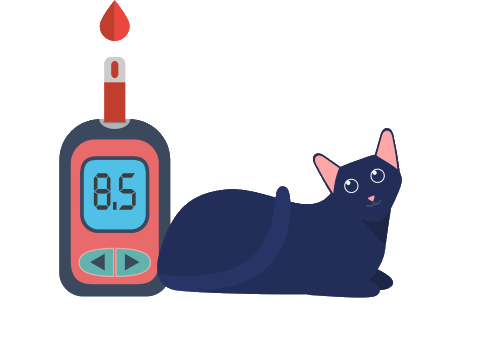
 Because of the dietary ancestry of cats, high carbohydrate diets are not good in cats as they are not used to breaking down these sugars in their diets, and so are unable to use them as effectively. However, the link between high carbohydrate diets and causing diabetes mellitus in the feline patient is unclear, and the current conclusion is a high carbohydrate diet does not cause diabetes mellitus. However, a low carbohydrate diet is still recommended in cats, as they are not as well equipped to use them as a dietary source.
Because of the dietary ancestry of cats, high carbohydrate diets are not good in cats as they are not used to breaking down these sugars in their diets, and so are unable to use them as effectively. However, the link between high carbohydrate diets and causing diabetes mellitus in the feline patient is unclear, and the current conclusion is a high carbohydrate diet does not cause diabetes mellitus. However, a low carbohydrate diet is still recommended in cats, as they are not as well equipped to use them as a dietary source.
My vet is recommending a therapeutic diet. Does my cat really need a special food?

 Dietary management of disease in patients is extremely useful and helpful to see them through to recovery. Therapeutic diets range from from dental biscuits which help to reduce plaque build up on the teeth and ultimate reduce the overall incidence of dental disease, to kidney diets which reduce strain on the kidneys and help to reduce progression of disease.
Dietary management of disease in patients is extremely useful and helpful to see them through to recovery. Therapeutic diets range from from dental biscuits which help to reduce plaque build up on the teeth and ultimate reduce the overall incidence of dental disease, to kidney diets which reduce strain on the kidneys and help to reduce progression of disease.
Urinary, kidney, liver, dental, weight loss, gastrointestinal, reduced allergen diets, reduced iodine diets (for hyperthyroid cats) and cats with sensitive stomachs and hairball build up are all examples of therapeutic diets which can help reduce the burden or progression of disease.
If your veterinarian has recommended a therapeutic diet, if your cat is happy eating that food then it is recommended to use that diet to ensure your cat has the best quality of life possible.
My cat is overweight. What should I be feeding her, and how often?
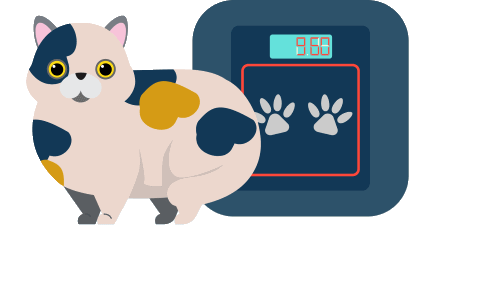
 Dieting in cats is hard work (unless of course you love the constant meowing of your furry friend). There are foods which help to make your cat feel more full and can help with weight loss, such as Royal Canin Satiety Food or Hill’s Science w/d food.
Dieting in cats is hard work (unless of course you love the constant meowing of your furry friend). There are foods which help to make your cat feel more full and can help with weight loss, such as Royal Canin Satiety Food or Hill’s Science w/d food.
Otherwise, if you wish to keep your cat on the same diet but lose some weight, reducing the amount given by one third is a good way to start.
If you normally always allow your cat access to food, then unfortunately this may have to stop to allow for a more controlled amount to be given and help with weight loss. As for how often should you be feeding your cat; once or twice per day is often adequate.
Which is better for my cat; dry food or wet food?
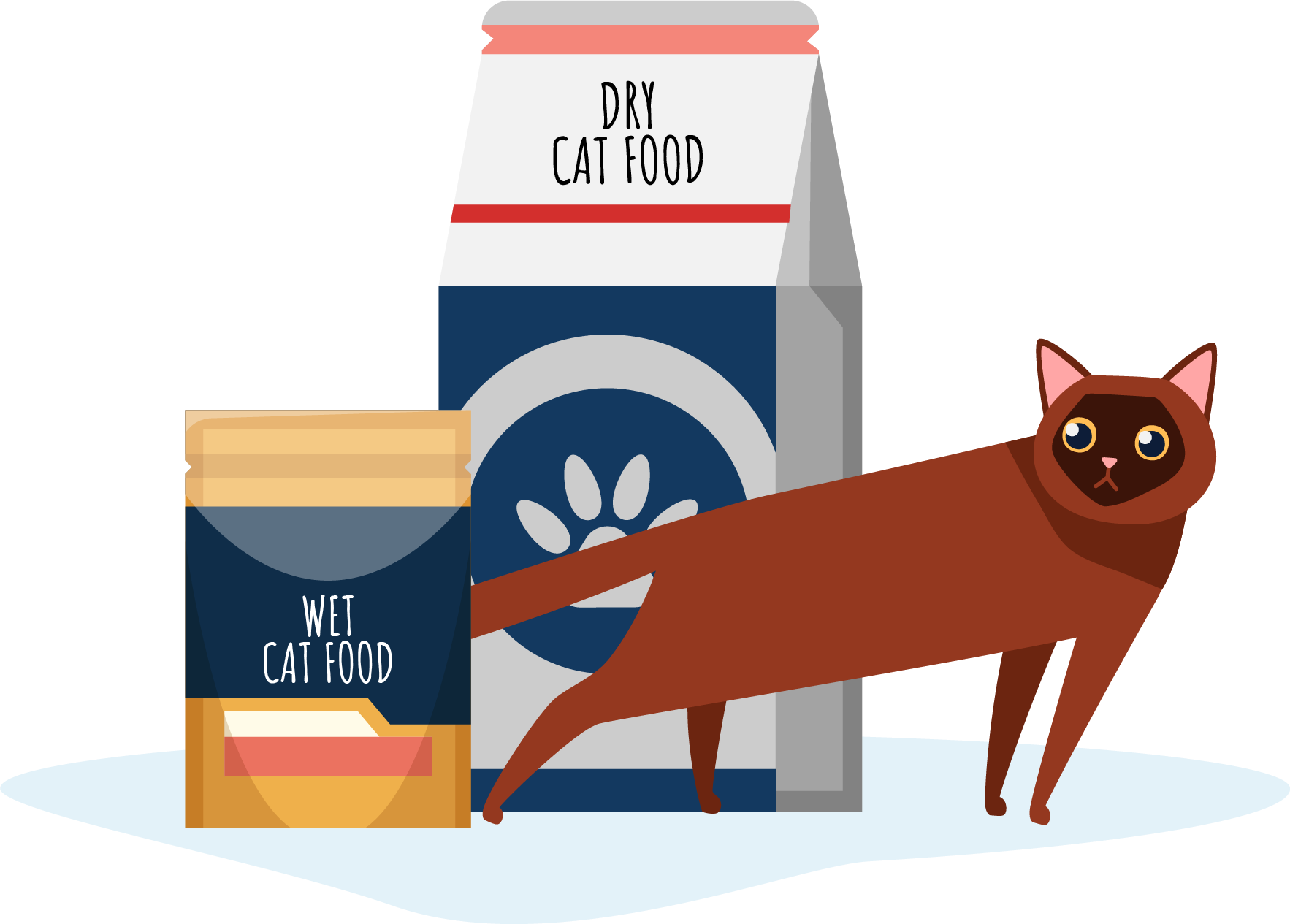
I suggest feeding dry food as it also helps to clean the teeth and encourages chewing action. Dry food is very reasonable as a sole diet, and your cat should have access to water at all times.
Wet food is delicious and is excellent to mix in with the dry food, but unless your cat has a reason to be eating wet food all the time (as recommended by the veterinarian) then I recommend a dry food as the main portion of the diet.
Should I free feed my cat?
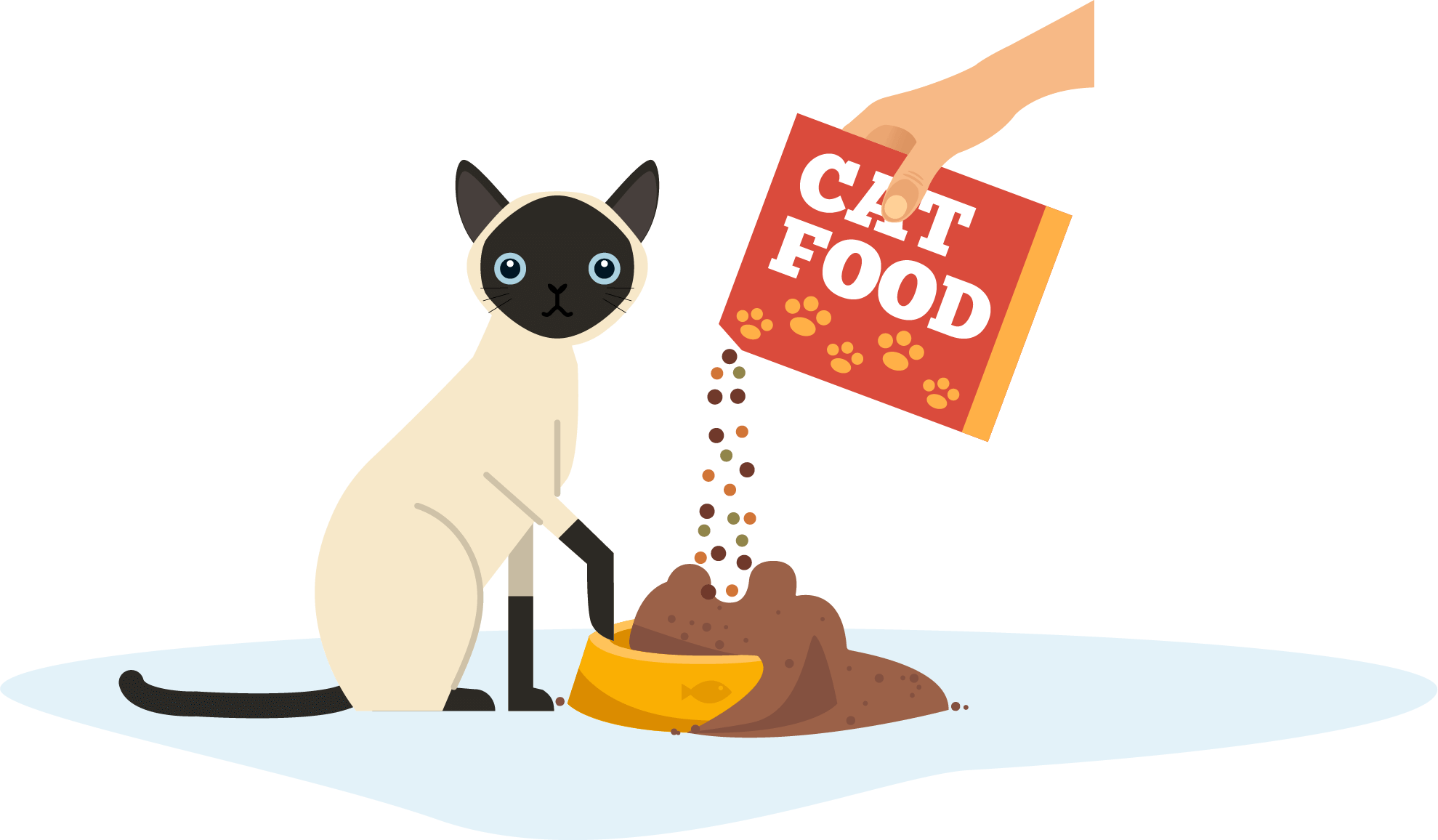
 Free feeding cats is when you offer them access to food at all times. In some cats this works very well, and they are able to control how much they eat and not put on excessive weight.
Free feeding cats is when you offer them access to food at all times. In some cats this works very well, and they are able to control how much they eat and not put on excessive weight.
However, some cats don’t have such great self-control and will eat too much and put on weight. In animals that put on weight, free feeding is not a good idea, and they should be restricted to only certain amounts of food per day. You have to work out if your cat has good self-control or if they eat a bit too much for you to be free feeding them.
Why is my cat chewing on grass/houseplants?

 This isn’t easy to answer, and there are a multitude of reasons your cat may be chewing grass. One reason may be that it helps them vomit, as they are unable to digest the plant material as they lack the necessary enzymes to break the plants down in the digestive system.
This isn’t easy to answer, and there are a multitude of reasons your cat may be chewing grass. One reason may be that it helps them vomit, as they are unable to digest the plant material as they lack the necessary enzymes to break the plants down in the digestive system.
This can help cats to purge the stomach of indigestible material such as bones and hair and is a natural thing for them to do in the wild. Another reason is that it may help to act as a natural laxative and push everything through the digestive system, making the passage of food through the colon slightly easier.
Sometimes cats also chew on the plants because of behavioural reasons, such as stress, anxiety or just out of curiosity. As long as the plant material your cat is chewing on isn’t toxic to them, then it is not concerning for them to chew on plant material.
Is it ok to feed my cat homemade cat food?
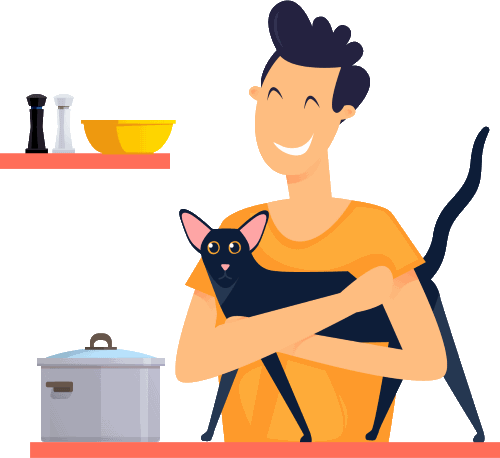
 Homemade cat food is a tricky business. If you are certain that the diet is fully balanced and has all of the requirements for your cats daily energy, vitamin mineral and protein requirements then this is acceptable.
Homemade cat food is a tricky business. If you are certain that the diet is fully balanced and has all of the requirements for your cats daily energy, vitamin mineral and protein requirements then this is acceptable.
However, this is not simple and consultation with a veterinarian or veterinary nutritionist is usually recommended to ensure that this is the case. Otherwise, commercial cat foods have been formulated to ensure they are fully balanced and provide all of the nutrients your cat needs for health and wellbeing.
Is premium cat food really better than the stuff from the supermarket?
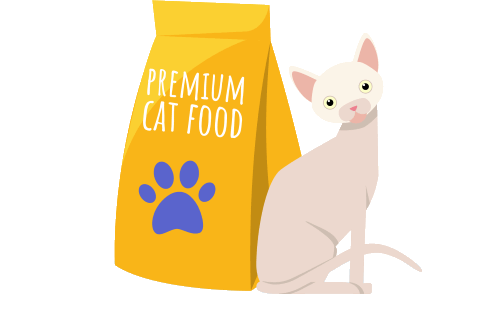
 Premium cat food is generally considered of a better quality because it has less “filler” or “ash” component in the food, which often means more is absorbed and there is less to come out the other end!
Premium cat food is generally considered of a better quality because it has less “filler” or “ash” component in the food, which often means more is absorbed and there is less to come out the other end!
Veterinarians generally recommend these premium brands because we know that that undergo stringent quality controls to ensure they are always fully balanced and of good quality.
However, registered, fully balanced cat foods are also available and are adequate to keep your cat healthy. Just don’t be surprised if the litter tray needs to be emptied slightly more often!
Is milk a good treat for cats?
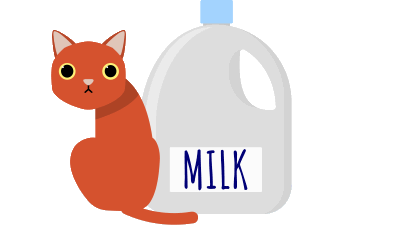
 Contrary to the fact that your cat probably loves milk as a treat, it is not a good treat for them. It often causes diarrhoea as cats lack the enzymes required to properly break down the sugars in milk. Diarrhoea can lead to dehydration and can leave your cat feeling generally quite ill, and so it is definitely not recommended to feed your cat cow’s milk as a treat.
Contrary to the fact that your cat probably loves milk as a treat, it is not a good treat for them. It often causes diarrhoea as cats lack the enzymes required to properly break down the sugars in milk. Diarrhoea can lead to dehydration and can leave your cat feeling generally quite ill, and so it is definitely not recommended to feed your cat cow’s milk as a treat.
Does my cat have to have a eat a grain-free diet?
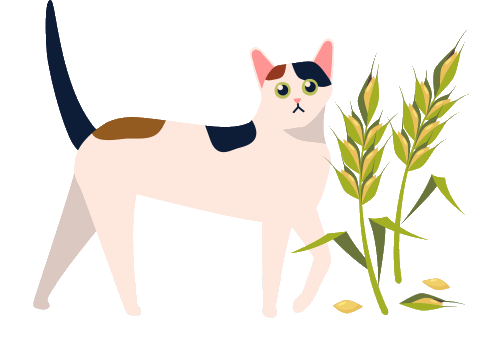
 No. The term “grain-free” is more of an advertising grab than anything else. It relies on the fact that we would think that feeding a grain-free diet would mean there are less carbohydrates in the diet, but in fact some of these diets contain more carbohydrates than regular grain-containing diets.
No. The term “grain-free” is more of an advertising grab than anything else. It relies on the fact that we would think that feeding a grain-free diet would mean there are less carbohydrates in the diet, but in fact some of these diets contain more carbohydrates than regular grain-containing diets.
Your cat does not have to eat a grain free diet. As long as the diet they are being fed is fully balanced and follows veterinary advice (eg: if a prescription diet is required) then the diet should be fine!
My cat has hairballs but refuses to eat hairball gel. What are some alternatives?
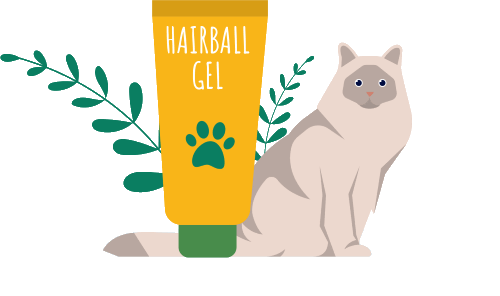
 Hairballs can be a difficult beast to tackle in cats! Some are very prone to getting them, and others can go a lifetime with no problems. Hairball gel is a very effective way of treating the problem, but if your cat doesn’t want to touch them, then there are a couple of alternatives.
Hairballs can be a difficult beast to tackle in cats! Some are very prone to getting them, and others can go a lifetime with no problems. Hairball gel is a very effective way of treating the problem, but if your cat doesn’t want to touch them, then there are a couple of alternatives.
The best way to prevent them would be to feed a diet specifically formulated to help the hair easily move through the digestive tract and not cause any problems; a specific hairball diet. Otherwise, ensuring that your cat is well groomed will help to reduce the burden of loose hair being ingested, but will not completely mitigate the problem.
If the hairballs are becoming a bigger and bigger problem and causing your cat serious issues, then its time to consult with your veterinarian about how to best manage the issue.

Dr John Blaxill
BSC BVMS
His main interests in veterinary medicine are small animal internal medicine, neurology, diagnostic imaging and oncology. Dr John enjoys both canine and feline medicine, and in the future hopes to work towards specialist accreditation within the facets of small animal medicine.
In his spare time, Dr John enjoys spending time with his [slightly chunky] Border Collie “Beau”, hiking, spending time eating and drinking beer with friends.
-
https://hare-today.com/feline-nutrition/nutrition/your-cats-nutritional-needs-the-basics
-
https://pets.webmd.com/cats/features/cat-food-101-what-you-need-to-know-about-feeding-your-cat#1
-
https://truthaboutpetfood.com/breed-specific-nutrition/
-
https://littlebigcat.com/health/urinary-tract-disorders-in-cats/?u=DakotaCat
-
https://www.youtube.com/watch?v=sh_PzBx1MVs
-
http://vetnutrition.tufts.edu/2017/07/research-update-new-insight-into-grain-free-cat-diets/
-
https://journals.sagepub.com/doi/abs/10.1177/1098612X17710842?journalCode=jfma
-
https://www.petfoodinstitute.org/the-whole-bowl/cats-vs-dogs-5-differences-nutritional-needs/
-
https://www.petfoodindustry.com/directories/211-top-pet-food-companies-current-data
-
https://endocrinevet.blogspot.com/2011/11/optimal-protein-requirements-for-older.html
-
https://healthypets.mercola.com/sites/healthypets/archive/2012/02/17/dry-food-wrong-for-cats.aspx
-
https://www.petfoodindustry.com/articles/8092-top-5-pet-food-industry-concerns-ingredient-quality-1
-
https://www.petbusiness.com/featured_articles/the-top-trends-in-dog-cat-food
-
https://www.petmd.com/dog/nutrition/evr_dg_whats_in_a_balanced_dog_food
-
https://pets.webmd.com/cats/features/cats-and-dairy-get-the-facts#1
-
http://vetnutrition.tufts.edu/2016/03/when-should-i-switch-my-pet-to-a-senior-diet/





